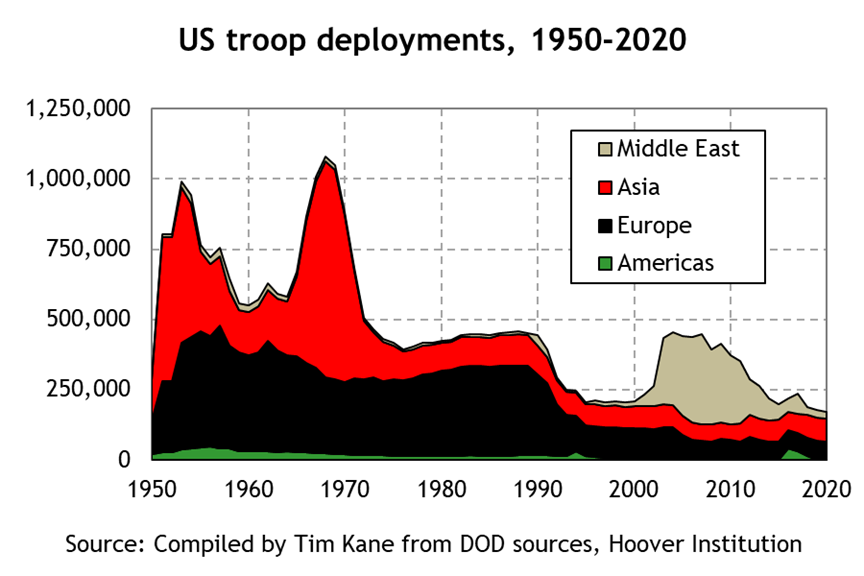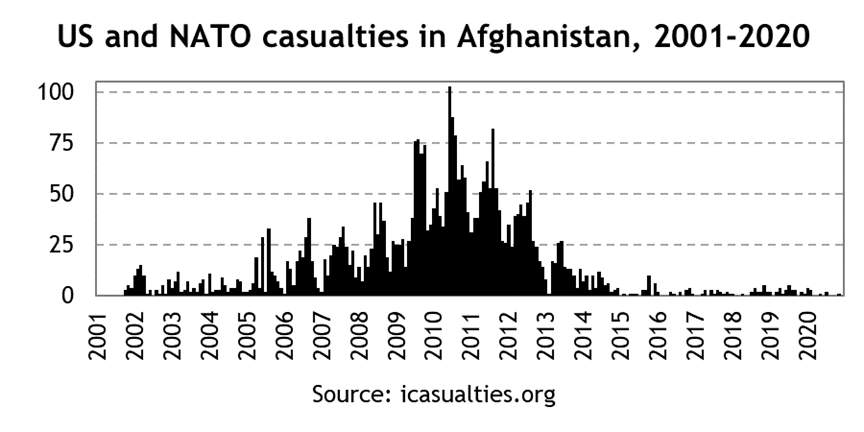False Choices In Afghanistan
Article by Timothy Kane in The Hoover Institution
False Choices In Afghanistan
Why was President Biden committed not just to a drawdown but to an absolute withdrawal of US troops in Afghanistan until there were zero?
Some say that Americans are tired after twenty years of war. That the United States has never been involved in a war this long before, that the American presence has had no positive impact, and that the troops themselves are exhausted. None of that is true, but worse, these claims defy many years of American experience in both warfighting and peacekeeping.
American forces have been at war in Korea, technically, for seven decades. There have been forty-four thousand US troops in Korea, on average, since combat ended in 1953. Three times as long as the longest war. They are still there.
Likewise, America and her allies were in a deadly Cold War with the Soviets for half a century, with US forces deployed in a dozen European countries along the Iron Curtain from 1945 to 1991, the year the USSR imploded. The United States had more than ten thousand American soldiers based in Italy, triple that in the United Kingdom, and twenty times more in Germany. They too are still there.
In 1995 and early 1996, the US military put tens of thousands of boots on the ground in Bosnia and Herzegovina to stop a genocidal conflict. As conditions improved, most were drawn down, but roughly six hundred and fifty US Army soldiers are deployed this very day at Camp Bondsteel in Kosovo. President Biden should know, as he visited those peacekeepers when he was vice president. They are still there—in a mission six years longer than the longest war.
The Binary Fallacy
Why base American overseas in the first place? (See Figure 1) Why keep them there forever? We might as well ask, why police the streets of Chicago forever? During a televised speech from the White House on the day after the Taliban took over Kabul, as refugees fell to their deaths trying to cling to US Air Force transport planes, Biden proclaimed: “I’ve learned the hard way that there was never a good time to withdraw US forces” and asked, “how many more lives—American lives—is it worth?”

Such questions suffer from a binary fallacy: engage or disengage. As Ben Domenech wrote on the same day, “The false choice here was Option A, stay there forever; Option B, this.” There were many options, and one was what might be called conservative: stay the course.
The isolationist describes his underlying philosophy as “realist” but genuine realism is recognizing a nonbinary spectrum of global conflict. There are guerrilla wars, proxy wars, stalemates, and in this case: cease-fires that require enforcement. If you’re buying the fiction that Afghanistan was a forever “war,” why have there been no American casualties since February 2020? (See Figure 2) There’s never been an American war where so few troops were doing so much good.

But the skeptics of Afghanistan engagement refuse to do an honest cost-benefit analysis. Instead they retreat into a “no benefits and exaggerated costs” fallacy, based on an immovable belief that there are trillions of dollars of sunk costs in Afghanistan.
Let’s think about scale. At the peak of the war fighting in Afghanistan there were one hundred and twenty thousand American soldiers deployed throughout the country. That was in 2011, during President Obama’s first term. In comparison, three times as many personnel were stationed in West Germany during the 1960s, ’70s, and ’80s. Forward-deployed troops in Germany were understood as vital deterrents and, yes, peacekeepers, a nuanced view catastrophically lacking in August 2021.
Obama slashed force levels in Afghanistan to ten thousand during the final year of his presidency—after very successfully brushing back the Taliban and reducing US casualties. But Obama never cut troop strength to zero.
Biden was handed a relatively modest mission involving the deployment of a mere twenty-five hundred US troops, all volunteers. Alongside were seven thousand members of allied forces from the countries of NATO, including Germany and the United Kingdom.
Three times as many American soldiers invaded Grenada in 1983 as were based in Afghanistan in 2021.
World leaders were shocked at the Biden administration’s plan for the Afghanistan end game. Biden chose the exact date for final withdrawal to coincide with the twentieth anniversary of the September 11 attacks, a ghastly and grim timing of retreat that surely thrilled terrorists everywhere.
What Good Have We Done?
Any honest cost-benefits analysis must include women’s rights. One of the reasons these rights matter, aside from the notion that such things have intrinsic moral value, is that female education rates have been proven to be one of the most significant variables driving economic development.
Just one of nine young Afghan girls were able to read before the US invasion. Ten years later, according to UNESCO, that literacy rate tripled. As Americans stayed the course and investments in education paid dividends, literacy improved to five out of nine girls in 2018. The literacy rate for the entire population of Afghanistan doubled after the United States got involved. Is that all because of the US military? Yes.
The lazy assumption is that Afghanistan is eternally undeveloped. This is a study in willful disbelief. Dare anyone to do a Google search for any human development indicator in Afghanistan. Look up children’s mortality, for instance. It’s been cut in half.
Unlike most conquering armies, American troops provide security and investment in the local populace of allied nations, cities, and villages. Once in Afghanistan, American generals and diplomats made a concerted effort not only to build schools but to support them, and to finance and construct basic utilities for electrification, water treatment, and sewage. All those efforts show up in the data. Such efforts have long been known as a “security umbrella.”
Before the September 11 attacks in 2001, fewer than one million children attended school in Afghanistan. In 2002, immediately after the US invasion, the number of children in primary school rose to 2.7 million. Earlier this year, it was 6.5 million.
The percentage of Afghan girls in schools was zero in 2000 and 2001. Suddenly, in 2002, over 40 percent of girls were in school. More than 80 percent have been educated during the past decade. Those are strategic gains, necessary for economic and social development that are anathema to jihadism.
Zero Is Not a Strategy
We return to the fetish of getting troops to zero in Afghanistan. Dozens of other allied countries host around two thousand American soldiers: Spain. Kuwait. Turkey. Djibouti. Qatar. We don’t call those deployments forever wars.
President John F. Kennedy had it right in 1962 when he spoke at West Point of a new kind of unconventional conflict that would deny freedom to the poorest countries: “When there is a visible enemy to fight in open combat, the answer is not so difficult. Many serve, all applaud, and the tide of patriotism runs high. But when there is a long, slow struggle, with no immediate visible foe, your choice will seem hard indeed.”
The lesson is this: the number of troops in a country is not an end in itself; rather, it is a means to an end. The ends, the reasons that Americans volunteer to serve abroad, are compassion, liberty, justice, and yes, peace. When he announced his withdrawal policy earlier this year—promising that Kabul wouldn’t collapse like Saigon—President Biden asked, “When will it be the right moment to leave?”
“2021” was the wrong answer. And no, the catastrophe in Kabul is not only a matter of how the United States disengaged—which the smart set are whispering as they throw Biden under the bus—it really is a matter of why. Why so impatient? Why no nuance? Why so hard to admit the mission was succeeding?
https://www.hoover.org/research/false-choices-afghanistan







Post a Comment